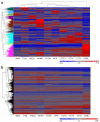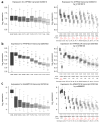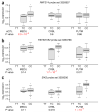Genetic variability in the regulation of gene expression in ten regions of the human brain
- PMID: 25174004
- PMCID: PMC4208299
- DOI: 10.1038/nn.3801
Genetic variability in the regulation of gene expression in ten regions of the human brain
Abstract
Germ-line genetic control of gene expression occurs via expression quantitative trait loci (eQTLs). We present a large, exon-specific eQTL data set covering ten human brain regions. We found that cis-eQTL signals (within 1 Mb of their target gene) were numerous, and many acted heterogeneously among regions and exons. Co-regulation analysis of shared eQTL signals produced well-defined modules of region-specific co-regulated genes, in contrast to standard coexpression analysis of the same samples. We report cis-eQTL signals for 23.1% of catalogued genome-wide association study hits for adult-onset neurological disorders. The data set is publicly available via public data repositories and via http://www.braineac.org/. Our study increases our understanding of the regulation of gene expression in the human brain and will be of value to others pursuing functional follow-up of disease-associated variants.
Figures








References
Publication types
MeSH terms
Associated data
- Actions
- dbGaP/UNKNOWN
Grants and funding
- G0501560/MRC_/Medical Research Council/United Kingdom
- K01 AG000947/AG/NIA NIH HHS/United States
- MR/L016400/1/MRC_/Medical Research Council/United Kingdom
- MC_G1000735/MRC_/Medical Research Council/United Kingdom
- Z01 AG000947/AG/NIA NIH HHS/United States
- 089698/WT_/Wellcome Trust/United Kingdom
- ImNIH/Intramural NIH HHS/United States
- G0901254/MRC_/Medical Research Council/United Kingdom
- MR/K01417X/1/MRC_/Medical Research Council/United Kingdom
- G-0907/PUK_/Parkinson's UK/United Kingdom
- P30 AG19610/AG/NIA NIH HHS/United States
- U24 NS072026/NS/NINDS NIH HHS/United States
- K-1212/PUK_/Parkinson's UK/United Kingdom
- P30 AG019610/AG/NIA NIH HHS/United States
- G0802462/MRC_/Medical Research Council/United Kingdom
LinkOut - more resources
Full Text Sources
Other Literature Sources
Medical
Molecular Biology Databases
Miscellaneous

